- Background
- The Realisation
- The Technology
- Your own, custom Android OS?
- How does a custom ROM like LineageOS help?
- What had I been doing wrong all these years?
- The problem with using Android and the Google Play ecosystem
- The Action
- Step 1: Choosing the software ecosystem
- Step 2: Choosing the degree of freedom and privacy you want
- Step 3: Biting the bullet!
- The Consequences
- Is this for you?
- A Small FAQ
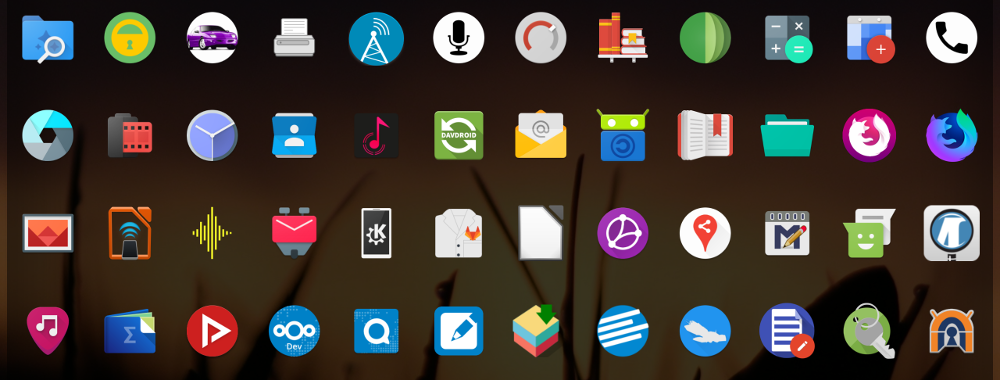
Background
I have been using an Android phone for about 6 years now. I have been using GNU/Linux exclusively since 1998. Hence, the desire to have a phone that provided me with the same freedom and flexibility has been very strong.
Unfortunately, a few months back I realised how I had accepted a life where I could have complete freedom and privacy on my computer but was content with having almost none on my phone. I was surprised at how I was ready to tolerate proprietary software (and evil practices) on my phone when I would never install or use such software on my computer.
This is an account of that introspection and my reasons to take various steps to have more freedom and privacy while still using Android on my phone.
The Realisation
For about 9 months now, one thing that was nagging me repeatedly was how easy it was for proprietary software to make its way into my life - getting past my most stringent checks and standards. I would download applications from the Google Play store, I would even pay to use some of them so that I could get rid of ads or get additional functionality and I would get blinded by how easy these apps made my life sometimes. Somehow, I found it okay to accept the proprietary nature of these software applications. For some reason, I did not subject them to the same standards that I subjected software on my laptop and servers.
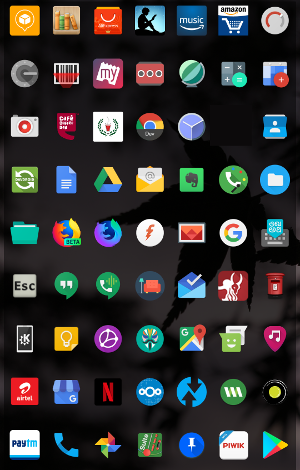
Proprietary software on my old Android phone
And then I realised that this was purely a convenience! I was blinded by this convenience and was sacrificing my privacy (and more). I was using proprietary software to make utility bill payments, to store notes and memos, to listen to music, to talk to acquaintances, to send pictures to family members and friends and so much more. Even though I was aware of free software replacements of these tools, at times, I would still not choose it because they, seemingly, weren’t good enough!
Would I take similar decisions had it been my laptop? Or a server? I don’t think so. Then why was I allowing myself to be sold? What was the reason for this apparent contradiction? How could I consider my value system to be consistent, if I made both these choices and accepted both of them? Or then, these must not be choices based on a common value system? I was, supposedly, holding myself to different standards in different situations!
The Technology
So what was it so unique about Android that it made it possible for me to do things that I really wouldn’t have wanted to do? How is that Android made it so simple to access and run proprietary software? Why was it so easy to forsake a mindful choice of using free software for the convenience that had other costs (loss of freedom and privacy) associated with it? To understand this, let me try to explain how Android phones are built.
What is Android really?
Android, essentially, runs the Linux kernel. It is not the standard, mainstream kernel, however. The Android system forks and independently maintains this forks of the Linux kernel so that it is suitable to run on handsets, tablets and so on. The Android Open Source Project (AOSP) is the parent project where all the development happens. AOSP includes a framework into which a device manufacturer can plug-in their device-specific code so that Android can work well with the features, limitations and hardware facilities available in the device.
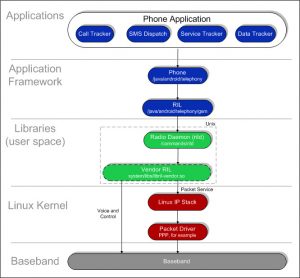
Android Architecture
There are certain parts of Android that are (almost) always implemented using proprietary software by device manufacturers. These parts include “the baseband” (a software system that controls all the communication components of a phone - the wireless, mobile radio, bluetooth, gps and so on), “some Linux kernel modules / drivers” (the AOSP-derived kernel with device-specific proprietary extensions) and “application software” (the launcher, the Google Play framework and services, location services, “useful” application software and so on).
How do you put Android on a phone?
When you buy an Android-powered phone, you receive a well-integrated software package that is aware of and customised / tuned for the hardware it is running on. The device manufacturer then provides you updates for this software. Since, we purchase the phone as a special-purpose device (who’s function is to make calls, provide Internet access, run application software etc.), we don’t treat it as a combination of hardware and software.
When we purchase or use a computer, we are very aware of this separation and distinction. On a computer, we know where our hardware ends and where the operating system (such as Debian GNU/Linux) starts. We are also, generally, aware of the fact that we can get the operating system to work in a similar manner on most other computers irrespective of the underlying hardware differences.
Android is also the same thing - its just our perception that is different. A phone manufacturer takes the AOSP (Android Open Source Project) source code (Google publishes it publicly whenever they make a new Android release), adds their device specific drivers and software and then put on a skin to make it look different or unique - an attempt to entice users with its “coolness” factor and functionality. This promotes the notion that the hardware and software are uniquely combined and welded together. And that to get the software functionality, you need to purchase the hardware as well. But that is not true at all.
Your own, custom Android OS?
It is possible to take the AOSP source code and recompile it yourself by adding the proprietary components from the device manufacturer. This would give you a “standard” or “vanilla” Android feel. Google’s devices usually have this feel since they are built directly from the corresponding standard AOSP source code. As long as the device you own allows you to install your own Android compilation (ie. it can be unlocked), you can completely remove all software that is provided to you by the device manufacturer and instead run your own custom-compiled Android version.
Once you are able to do that, you can realise how clear the separation between the hardware and software on a phone is. You will also understand that hardware itself is only half the story – the hardware is useless unless it is driven by the right software. (So if there is no free software component available to drive a particular hardware on the phone - perhaps a dual-camera or a sensor - you will not be able to use it in your custom-compiled Android unless you also use the device manufacturer’s supplied proprietary software.)
There are many projects that seek to do exactly this. They take the AOSP source code and the proprietary device-specific code for a specific phone and pre-compile and package it so that you can install and use it, if you choose to. The LineageOS project is the most prominent and comprehensive project that aims to support a wide variety of devices. Most other projects such AOKP, Resurrection Remix, Paranoid Android etc either use LineageOS as a base or AOSP directly. All of these provide you with pre-compiled, easy-to-install and immediately usable Android images that you can flash on a variety of devices. They also publish the corresponding source code on Github or elsewhere so that you can rebuild the same Android image yourself.
How does a custom ROM like LineageOS help?
By using LineageOS (and other such distributions) on your phone, you achieve consistency in the user experience across devices. If you install LineageOS on three different devices, the end result will be similar - you will get the same AOSP-based user interface with a mix of add-on apps developed by the LineageOS team to make the end-result more usable.
Just like installing Debian across computers of different hardware configuration and architectures provides the same consistent user experience, so does LineageOS (and other such distributions). You no longer need to put up with bloatware and user interface skins provided by your device manufacturer. If you device is supported by LineageOS, you can simply install Lineage on it and feel comfortable with its user experience. No matter which device you use, you will find the same set of settings options and the same default apps.
After that, if you want, you can still install and use Google services and make your phone function like a phone that is a part of the “standard” and “default” Android ecosystem.
What had I been doing wrong all these years?
Ever since I owned a Google Nexus 4 device some 5 years back, I had been using LineageOS (then called Cyanogenmod) on my phone. I would choose my phone based on its ability to run an unofficial, community developed and packaged Android distribution. I would then proceed to remove the default Android OS and install this “unofficial” distribution to make my phone usable.
The mistake I was making for all these years was to then install a special GApps package to get the functionality of the Google ecosystem on my phone. (LineageOS can not ship with this proprietary Google Play functionality because of licensing restrictions. It has to be downloaded and installed separately.) This gave my phone the ability to use Google Play services and install software from the Google Play store. And that is where the road to proprietary software and tracking starts!
The problem with using Android and the Google Play ecosystem
While there are quite a few applications in the Google application catalog that are free software, a bulk of the applications are not. Chances are that almost everything that you use regularly is proprietary. In other words,
- It does not ship with source code,
- The developer is the only one who knows how it works or what it does,
- It probably relies on Google Play services to send notifications or integrate with other apps,
- It possibly uploads your data to the developer's (or a third party's) server for backup / analytics / data-mining / sending alerts etc, and
- it might use file formats that might be proprietary in nature.
So if you use the application a lot and use it to manage a lot of data, you will probably need to continue using it to access your data. If you delete the app from your phone, that does not automatically scrub your data from their servers. If you re-install the app, you can access your data again. Effectively, you become locked-in to the app and its functionality. What might have begun as a convenience, is now a compulsion.
What if you have real money stored inside the app? Or your coffee shop rewards points? Or your favourite taxi operator’s routes? They are all accessible only if you use that app. You would completely loose access to them if you stopped using the app.
And this is the problem with the Google Play ecosystem. It pushes proprietary software to you, it enables application developers to lock you in by using proprietary data storage and access techniques, it tracks what you do on your phone (so that it can offer better suggestions / advice / notifications to you) and its cripples your ability to be in control of the technology you use for managing your day-to-day life.
While I was aware of all these issues, I ignored these dangers. While I would passionately talk about the value of choosing software freedom everywhere, somehow, I was okay with how this mobile operating system was snatching away what I valued most – my freedom and privacy.
The Action
This January, I purchased a new phone that could be unlocked and on which I could run Lineage OS without issues. I decided to choose a phone that had official LineageOS support so that I could continue to get updates. I also wanted to make sure that the source code for the device I was going to choose was available and updated. Hence, I chose the Samsung Galaxy S7 phone. It was good enough for my needs and for what I was planning to experiment with.
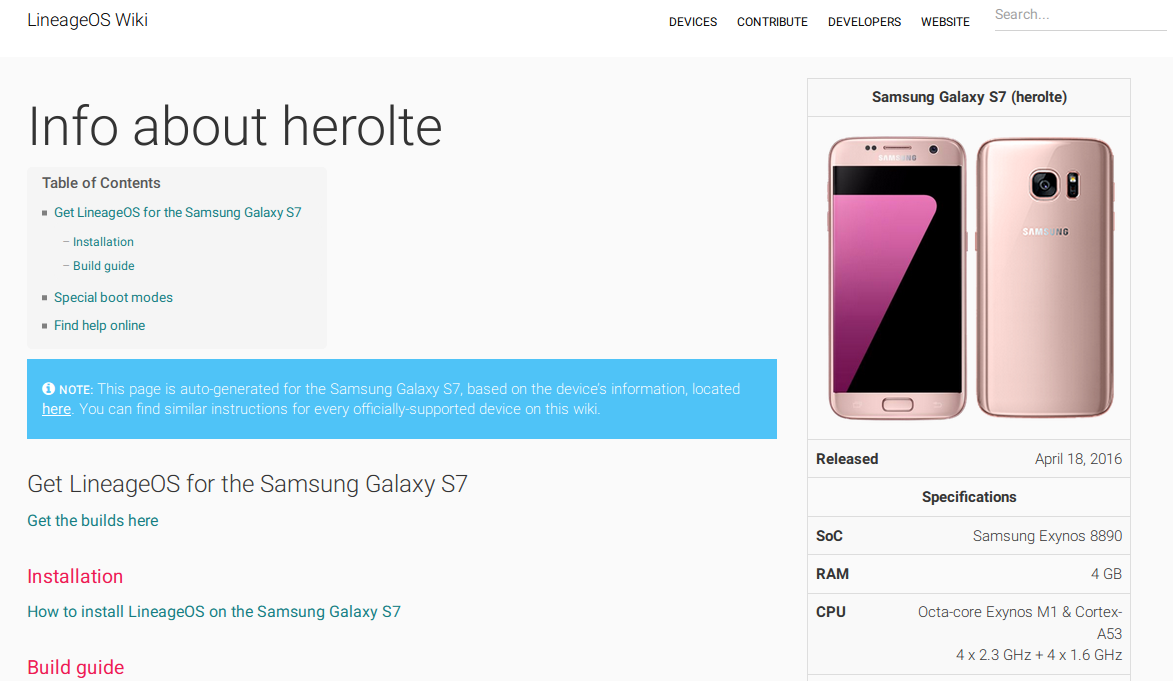
Samsung Galaxy S7 page on the LineageOS Wiki
Step 1: Choosing the software ecosystem
I then unlocked the phone and installed LineageOS on it. Of course, this time, I had no intention of installing Google Play services or any other proprietary tools. Instead, I have chosen to only install software that is distributed via the F-Droid repository or independently as a package built from published source code.
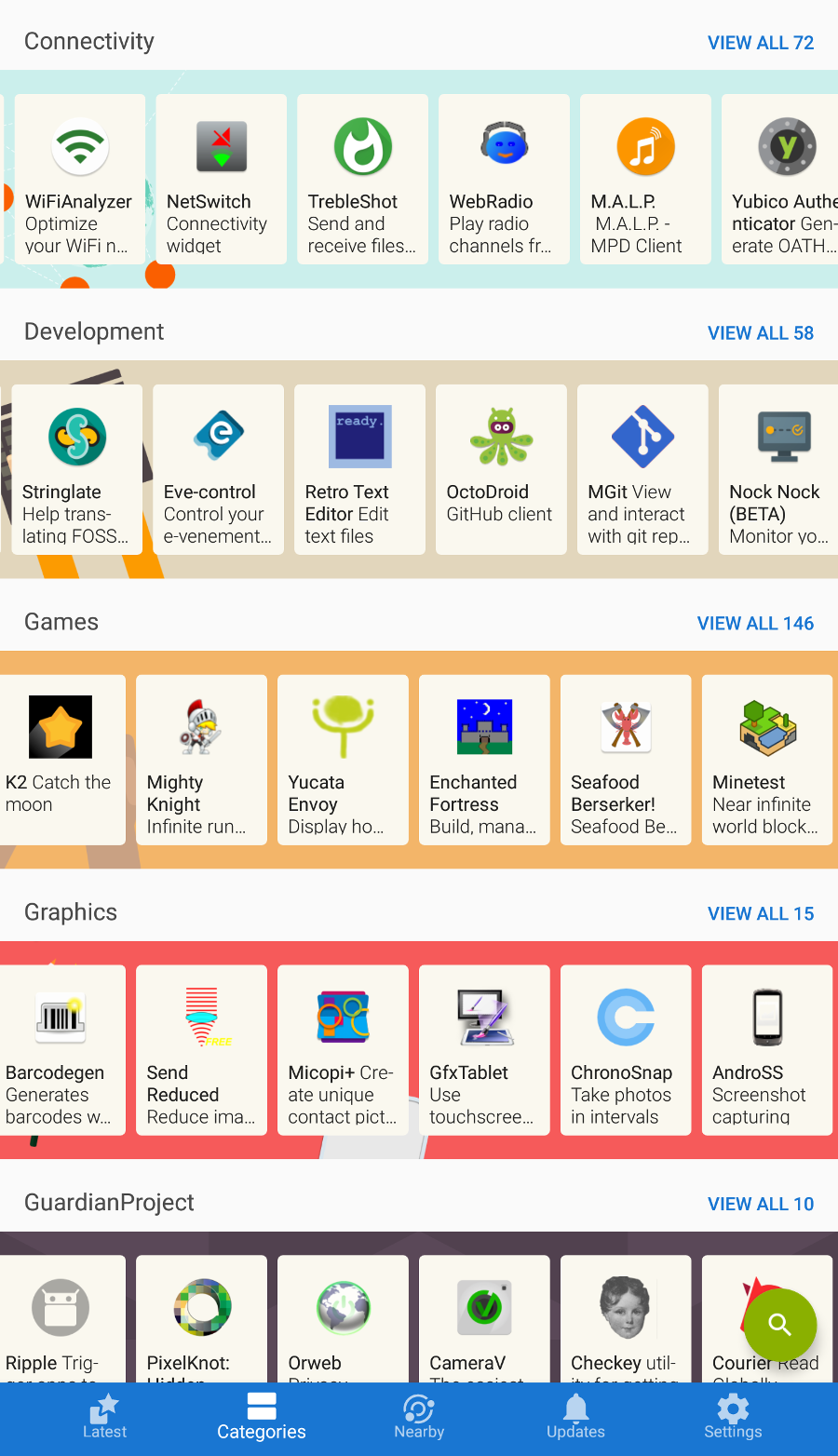
The F-Droid Application Repository
This is not a very difficult challenge, actually. Today, there are a lot of very high-quality free software applications for Android. You can find applications for all your needs on F-Droid. When you install an app from the F-Droid repository, it is guaranteed that the application is free software in the purest sense of the definition. They specifically list and classify applications in case they have any of the following anti-features:
- the application contain Ads
- the application tracks you (by default)
- the application uses or promotes non-free network services
- the application has or promotes non-free addons
- the application has non-free dependencies
- the application is derived from a non-free upstream application and is specifically patched for f-droid compatibility
- the application has some known vulnerability,
- the application uses a disabled algorithm
If you still choose to use the application, you will do so with the awareness that it possesses one or more of these anti-features.
Step 2: Choosing the degree of freedom and privacy you want
In spite of everything I have discussed above, it is still possible to install and use proprietary Android apps on your LineageOS phone - without even having to install Google play services. But choosing to do that defeats the very purpose of this whole exercise. There are three things you might need to consider when you’re challenged with a proprietary Android app:
-
Are you choosing to install a non-free software application on LineageOS - ie. is it an application who’s source code is not available and is not licensed under a Free / Open Source Software license?
-
Are you choosing to install a free software application that consumes or promotes a non-free network service? (Eg. F-Droid has “Telegram” in its repository and this Telegram client is built using the source code published by the Telegram team. However, even though the software is free, it still forces you to use a non-free / non-self-hosted network service. Another example of this might be a file-sharing or sync system. Or a music streaming service.)
-
Are you choosing to install a proprietary app which depends on a proprietary network service? … and you’re choosing to do so because, in the interim, you can’t leave that “network” overnight. Or avoid using that service altogether. (Eg. Installing or using WhatsApp is an example of this. Or using a video streaming service.)
Each of these compromises make dent into your freedom and desire for greater privacy. If you are going to make any of these choices, then it would be useful to make them mindfully so that you are also aware of their side-effects and hence, can take requisite precautions to protect yourself from the undesirable ones.
Step 3: Biting the bullet!
Finally - you will just have to decide, one day, that you’re going to do this exercise mainstream. I did that after I had carefully installed and configured the most useful applications required. I still had my old phone which still had proprietary apps but I decided not to use that phone or only use it for messaging till I could encourage everyone who needed to communicate with me to use alternate channels.
I did not face any major inconvenience. Surprisingly, it was a great learning experience. (Surprisingly because I thought I knew whatever there was to know about LineageOS + Android since I’d been using it for many years.) Its only when you do an exercise like this, that you realise how many important aspects of your life actually rely on non-free and proprietary software.
But I was happy with the choices I was making. It was refreshing to not use proprietary apps on my phone. It was good to be in sync with my value system again. I was proud to tell everyone (not that most people care, but still…) that I was not using proprietary software on my phone any more.
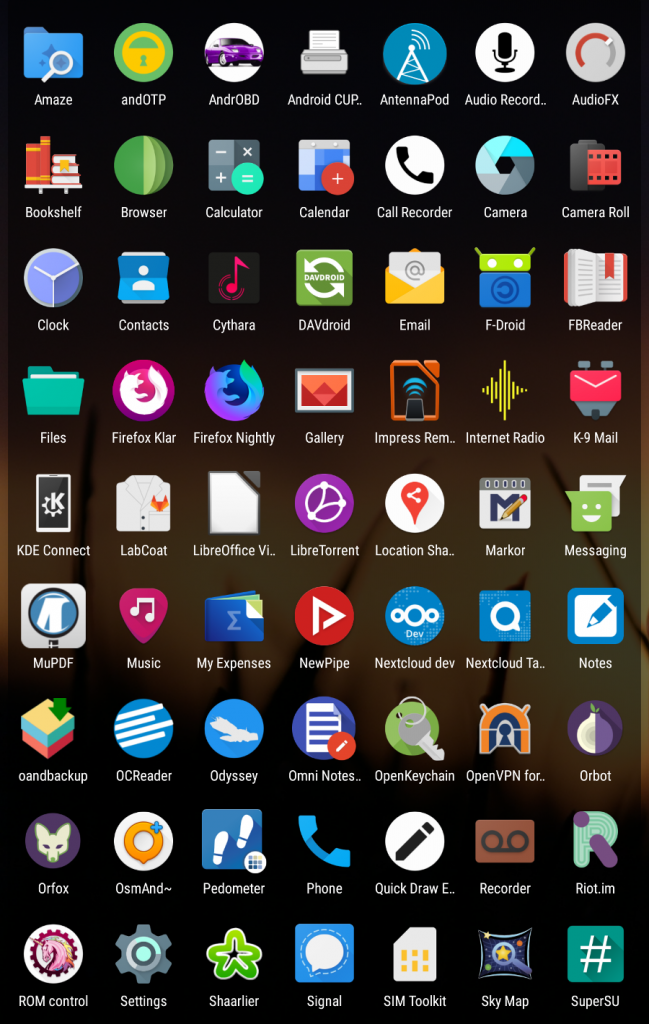
Free Software Android apps on my phone
The Consequences
Let discuss the after-effects of my shift:
1. Since my preferred method of communication was not what most people liked to communicate on, it took some effort to encourage others to use free platforms for communication. I prefer email, Riot/Matrix, SMS and calls (in that order). But I can’t impose these choices on others.
2. I gradually stopped using proprietary and tracking-heavy chat platforms such as WhatsApp and Google Hangouts completely. Since I never checked messages there, people were forced to seek me out using other means and that’s a definite plus. I think I can delete my accounts now.
3. As a compromise, I chose to be present on a few other communication platforms that at least (a) had free software client apps and (b) were known to be privacy respecting systems.
4. Since I was already using a personal Nextcloud instance to sync my data and manage other aspects of technology (where proprietary cloud apps usually come in), I simply continued to use those practices seamlessly on my new phone. I did not have any data (files, photos, emails, contacts) on any other network service.
5. I further extended my self-hosted tool-set to include a ebook library, a bookmarking system, a read-it-later system and a RSS-based news reader.
6. Since none of the taxi services or banking, payments and wallet services are free software, I just stopped using them. I also realised that some of them won’t even let me delete my account and so I have started bugging their customer support teams to do it for me.
After using this ecosystem for about 4 months now, I can confidently say that I have no regrets and I don’t face any loss of productivity in any way. If I feel inconvenienced or limited, I remind myself of how I did not give up on GNU/Linux twenty years back.

Maps with OSMand + OpenStreet Map
Is this for you?
I expected at least a few people to ask me if they should do this as well. But over the past 4 months, no one has asked me this question, yet! But let me answer it anyway.
This is definitely an option for you. At the same time, you also have to understand that you will invite some inconvenience along the way and when you do, you should be ready to wade through it and keep going forward. There is no difference to make and there is no critical mass to reach if we give up easily instead of trying to find alternate solutions.
Making the set of choices I have made can be tough initially. If you care enough, you will find it easy to make these decisions and I am here to help you out. Finally, making these choices and retaining them boils down to how important it is for you to use Free Software on your computing and communication devices. If that is not something that you want to compromise on, then you’re all set. I am confident that you will make these choices and stay on course.
Here is a further FAQ to guide you.
A Small FAQ
Q: Have you really stopped using all proprietary apps on your phone?
A: Yes. My primary phone no longer has any proprietary software on it. Any non-free network services that I use are fueled by apps released a free software.
Q: So there is no proprietary software at all on your phone?
A: Its not possible to have a phone made-up of free software entirely. Due to the nature of the phone hardware industry, the firmware that drives the baseband (ie. the networking components of the phone) is implemented as proprietary software. There is also other microcode and firmware that is required to use the SoC (System-on-a-Chip), to use the GPU (Graphics Processing Unit) and so on.
The Librem 5 phone will change much of this when it launches. Keep checking their progress to see how they’re faring.
Q: Are there any other GNU/Linux-based operating systems for mobile devices?
A: SailfishOS is a promising mobile operating system that works and is available for use right away. It is possible to use KDE Plasma on some phones. The Ubuntu Touch project was aimed at build a converged Ubuntu-based mobile operating system.
For a truly free re-implementation of Android, that is mostly blob-free, check out the Replicant project.
Q: If you cheat by using App ‘D’, how can you say that your choices are consistent with your stated value system?
A: This is how I look at it: I have have been able to eliminate all aspects of proprietary software that affect my work, productivity or life in any way. I don’t store any data on a proprietary network or cloud service and I self-host everything that I need. If I am using any proprietary software, I have it on my old phone.
On that phone, I have removed everything other than some entertainment apps. Then - are these apps my weakness? Am I going to justify my choice of using them by saying that they are just entertainment and not connected to my work or life? No - I wouldn’t say that. I, myself, am a work in progress. My choices are changing rapidly as well. I have no dependency on proprietary software or network services to lead my life. Each day, I draw the circle closer.
Q: How do you do ‘X’ now? What is the free software replacement for ‘Y’?
A: That is a very good question. I intend to write a follow-up article on all the apps I find useful and how I have replaced this “X” and “Y”.

Please feel free to write to me if you made a similar choice or need help in making it.

